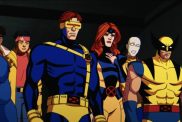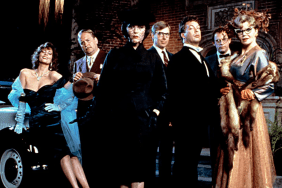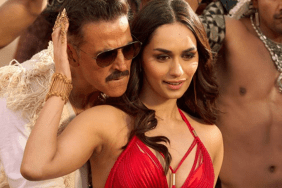This month would have seen the release of Denis Villeneuve’s Dune: Part Two. However, due to the strikes in Hollywood, Legendary and Warner Bros. opted to postpone the big-budget release to March 2024. The reason for this decision was that the artists behind the project could not promote the film via talk shows, interviews, etc.
That got me thinking about the box office. Specifically, do movie stars drive worldwide box office numbers? Would Dune: Part Two have flopped without its stars making the media rounds in this case? Or would it have found the same success as Taylor Swift’s Eras Tour and the recent Five Nights at Freddy’s?
Looking back on the year, the top five box office hits of 2023 are as follows: Barbie, The Super Mario Bros. Movie, Spider-Man: Across the Spider-Verse, Guardians of the Galaxy 3, and Oppenheimer. Each film boasts talent. Barbie features Margot Robbie and Ryan Gosling, Mario and Guardians feature Chris Pratt, while Oppenheimer boasts Christopher Nolan‘s name above the title. Were these films enormous successes because of these names?
Debatable.
Margot Robbie’s track record has been hit or miss since her breakout role in Martin Scorsese’s The Wolf of Wall Street. Before Barbie, her biggest worldwide earner was 2016’s Suicide Squad ($745M), followed by Once Upon a Time in Hollywood ($377M). Those films were ensemble pictures with enormous casts and stars such as Will Smith, Leonardo DiCaprio, and Brad Pitt. Robbie’s Harley Quinn solo act, namely Birds of Prey ($201M), was seen as a flop, while Amsterdam ($29M) and Babylon ($63M) were pricy misfires.
Ditto with Gosling, who appeared in the critically acclaimed but financially disappointing Blade Runner 2049 ($257M), First Man ($105M), Gangster Squad ($104M), and The Nice Guys ($59M). His biggest successes were La La Land ($435M) and the comedy Crazy, Stupid, Love ($146M).
Audiences flocked in part to see the hilarious performances given by Robbie and Gosling in Barbie. Indeed, ads heavily featured Gosling’s dimwitted Ken and Robbie’s sparkling Barbie — roles the two actors were seemingly born to play. Would the film still be a hit if you recast Barbie and Ken with two lesser actors?
Again, debatable.
Similarly, Chris Pratt lends his voice to Mario and stars in Guardians of the Galaxy Vol. 3, but was he the reason audiences turned out in droves for those pictures? Nolan’s last picture, Tenet, proved a commercial disappointment, but he struck gold with Oppenheimer, an R-rated, 3-hour historical epic that has earned nearly a billion dollars worldwide. Did Nolan’s name attract moviegoers or the fascinating subject matter and flashy ad campaign? Or both?
It’s a fascinating exercise to decipher the success of blockbuster films. In 2022, Top Gun: Maverick soared to astronomical heights, leaving box office analysts scratching their heads. The film grossed a massive $1.5B at the global box office. It cemented Tom Cruise as the last great Hollywood movie star until this summer when Mission: Impossible – Dead Reckoning Part One flopped with just $567M worldwide despite tremendous reviews and positive audience scores. So, maybe Top Gun wasn’t about Cruise’s limitless appeal.
Indiana Jones and the Dial of Destiny with Harrison Ford only brought in $383M, and Fast X with Vin Diesel grossed just $145M in the US ($704M worldwide). At the same time, high-priced vehicles like Dungeons & Dragons: Honor Among Thieves ($208M WW) and The Flash ($270M WW) crashed and burned despite featuring a plethora of star power – Chris Pine, Ben Affleck, Michael Keaton, Michelle Rodriguez, etc.
Conversely, The Equalizer 3 raked in $187M on Denzel Washington’s name alone, while John Wick: Chapter 4 earned Keanu Reeves his biggest hit since The Matrix Reloaded (Toy Story 4 doesn’t count).
So, what’s the answer? Do movie stars drive the box office? The answer is both yes and no. Audiences, specifically women, were drawn to Barbie for various reasons — the pink color scheme, the overt femininity, the social media campaign, Margot Robbie’s gorgeous smile, and Ryan Gosling’s handsome mug. Of course, the stars factored into the success, but Barbie would always be a hit based on the brand name alone.
Comparatively, flash back to 1993. Jurassic Park, The Fugitive, The Firm, Sleepless in Seattle, Mrs. Doubtfire, Indecent Proposal, In the Line of Fire, Aladdin, Cliffhanger, A Few Good Men, Groundhog Day, and Dave comprised the year’s biggest earners. Save for Jurassic Park, every film on that list features an out-and-out A-list superstar who carried the picture on their back. Harrison Ford, Tom Cruise, Tom Hanks, Meg Ryan, Robin Williams, Clint Eastwood, Robert Redford. Sylvester Stallone, Bill Murray, Kevin Kline, Sigourney Weaver … all films marketed with star power.
In other words? No one went to see Sleepless in Seattle because the story looked good. They wanted to see Tom Hanks and Meg Ryan. Similarly, Mrs. Doubtfire boasts a funny concept, but would it have worked without Robin Williams? Ditto with Aladdin.
Most modern films, specifically superhero flicks, aren’t guided by star power. Look at the biggest movies of the last decade — nearly all are well-known IPs or high-concept pictures with massive casts rather than a film driven by a superstar. People turn up to see Captain America, not Chris Evans; dinosaurs, not Chris Pratt; and Spider-Man, not Tom Holland. Sure, we like these actors in these roles, but would a new Jurassic Park make less money without Chris Pratt and Bryce Dallas Howard?
The 1990s were awash with high-concept blockbusters like Jurassic Park and Independence Day. Still, movies like Forrest Gump, Men in Black, Armageddon, Terminator 2, Ghost, Pretty Woman, Mission: Impossible, Dances with Wolves, The Green Mile, etc. revolved around their superstars. Robin Hood: Prince of Thieves shot its way to $390M worldwide thanks to Kevin Costner, True Lies made over $365M on Arnold Schwarzenegger’s broad shoulders, and any movie featuring Tom Hanks or Julia Roberts was guaranteed to hit $100M.
Look, it’s a different world. Audiences are pickier, and there’s far too much content on TV to keep us home on a Friday evening. In 2000, Tom Hanks’s mug was enough to lure audiences into cinemas. Today, we require more convincing via trailers, TV spots, reviews, and Rotten Tomatoes scores.
In the case of Dune: Part Two, I believe it was a mistake for the studio to push the film to March, especially since there’s zero competition this month. I mean, The Marvels is expected to produce mediocre numbers, Disney’s Wish likely only appeals to families, and analysts expect Ridley Scott’s Napoleon to reach roughly $24M in its opening weekend. We need a big-budget blockbuster to hold our interest through the holidays, and Dune fits the bill.
Again, the studio wanted to wait until next year so that the film’s stars could promote it. And again, I don’t think Dune’s box office hopes hinge on whether or not Timothée Chalamet lip-syncs with Jimmy Fallon. Audiences are beyond that. If a film looks good, they’ll go and see it. If a movie looks like crap, they’ll stay home. Simple as that.
Is the movie star dead? There may be no clear-cut answer. Star power may intrigue audiences, but the days of rushing to see the next big (INSERT ACTOR NAME) flick are long gone. I can’t recall the last time I saw a movie specifically for an actor. That’s not a knock on the talent, just an observation.
What do you think? Is the movie star dead? Are you still drawn to star power? If so, who are some big names that lure you into cinemas? Sound off in the comments!










